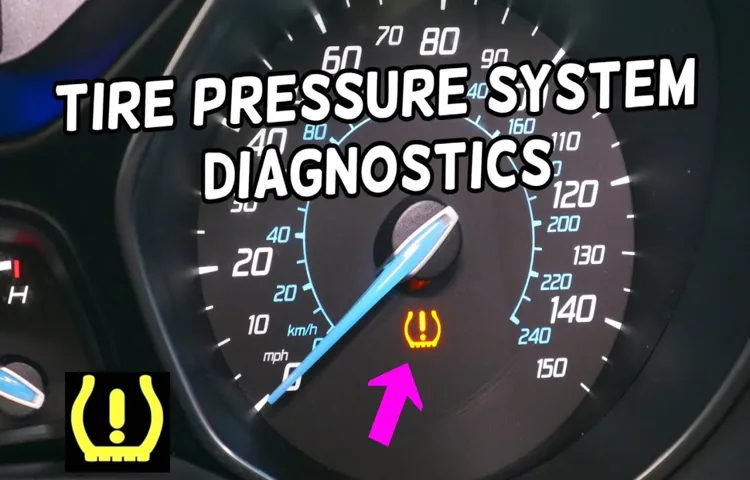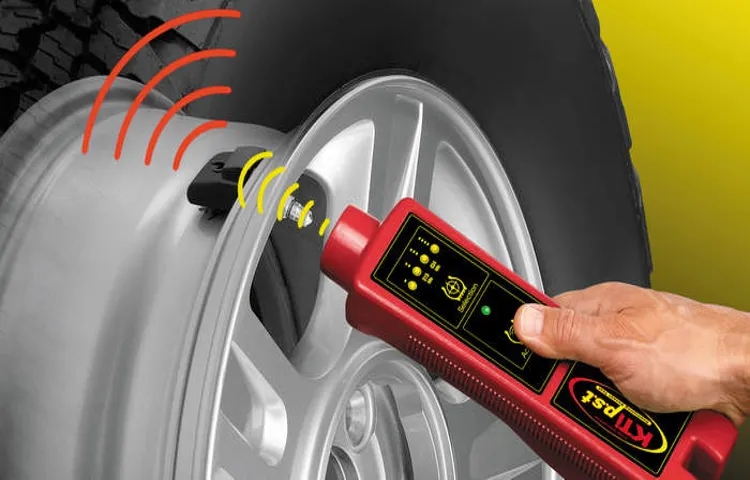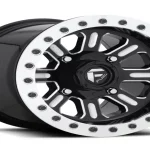Have you noticed that your tire pressure warning light keeps coming on, even though you’ve just filled up the tires? If so, you could have a bad tire pressure sensor. These sensors, also known as TPMS, are responsible for monitoring the air pressure in your tires and alerting you if anything is off. However, they can sometimes malfunction, causing unnecessary stress and confusion for drivers.
But how do you know for sure if it’s a bad tire pressure sensor? Well, there are a few telltale signs to look out for. For example, if the warning light comes on repeatedly, even after you’ve checked and adjusted the tire pressure, that could be an indication that something is wrong with the sensor. Additionally, if you notice that the pressure readings on your dashboard don’t match up with an external pressure gauge, that’s another red flag.
Ultimately, the best way to determine if you have a bad tire pressure sensor is to take your vehicle to a trusted mechanic or dealership. They can run diagnostic tests and help pinpoint the issue. But if you’re handy with cars and want to try troubleshooting on your own, there are a few steps you can take, such as checking the TPMS fuse or resetting the system.
No matter what route you take, it’s important to address any issues with your tire pressure sensor as soon as possible. Not only can a faulty sensor lead to incorrect readings and unnecessary anxiety, but it can also compromise your safety on the road. So, don’t ignore those warning lights – take action and get your TPMS checked out.
Table of Contents
Understanding Tire Pressure Sensors
If you suspect that your tire pressure sensor may be bad, there are a few things you can do to confirm your suspicions. The first step is to check your tire pressure manually with a gauge to see if there are any discrepancies between each tire. If everything appears normal, it’s worth checking for any flashing warning lights on your dashboard, which could indicate a malfunctioning sensor.
Additionally, you can try resetting the sensors by deflating and reinflating your tires to the recommended pressure levels. If the sensor doesn’t reset, it may be time to take it to a mechanic for further inspection. Ultimately, it’s essential to address any issues with tire pressure sensors to keep your vehicle running smoothly and safely.
How Tire Pressure Sensors Work
Tire pressure sensors are electronic devices in your car that alert you of any changes in tire pressure. They function by measuring tire pressure and transmitting a signal to the car’s onboard computer, which analyzes the data and relays it to the driver via a warning light on the dashboard. This technology is integrated with a variety of vehicles to ensure safe and efficient driving.
If your tire pressure is too low, the computer will send out a warning signal to you indicating that it is time for a refill. Neglecting low tire pressure can lead to flat tires, decreased fuel economy, or an overall low-performance vehicle. By installing quality tire pressure sensors, you can prolong the lifespan of your tires and keep your driving smooth and safe.

Types of Tire Pressure Sensors
Tire pressure sensors are becoming an essential aspect of modern-day vehicles. Understanding the types of sensors can save you time and money in the long run. The first type of tire pressure sensor is the direct sensor.
It works by utilizing a valve-mounted sensor that communicates tire pressure readings to the vehicle’s onboard computer. The second type of tire pressure sensor is an indirect sensor. Unlike the direct sensor, it does not communicate the tire pressure readings to the onboard computer.
Instead, it uses wheel speed sensors to determine if there is a decrease in tire pressure. Finally, some vehicles come equipped with a hybrid system that combines both direct and indirect tire pressure sensors. This system provides drivers with the best of both worlds.
Overall, understanding the different types of tire pressure sensors in your vehicle can help you recognize and resolve any issues before they escalate.
Signs of a Bad Tire Pressure Sensor
If you’re wondering how to find a bad tire pressure sensor, there are a few signs you can look out for. One common giveaway is a dashboard warning light that looks like an exclamation point inside of a horseshoe. This light will typically appear next to the tire pressure indicator on your dashboard and illuminates when there is an issue with one or more of your tires.
Additionally, if your tire pressure is consistently low despite inflating your tires regularly, it could be a sign of a bad tire pressure sensor. Another potential clue is if your tire pressure monitoring system is transmitting inaccurate readings, which can cause inconvenience and safety hazards. In cases like this, it may be time to bring your vehicle to a trusted mechanic for a diagnosis and replacement of the malfunctioning tire pressure sensor.
Dashboard Warning Light
If you’ve ever been driving and noticed the tire pressure warning light appear on your dashboard, it’s important not to ignore it. This indicator is a sign that your tire pressure sensor may be faulty, and it’s crucial to address and fix this issue as soon as possible. A bad tire pressure sensor can affect your car’s overall performance and safety, causing problems with handling and even leading to tire blowouts.
Signs of a bad tire pressure sensor include constantly fluctuating tire pressure readings, inaccurate pressure measurements, and a persistent warning light on your dashboard. If you suspect your tire pressure sensor might be faulty, take your car to a trusted mechanic to diagnose and fix the issue promptly. By addressing the problem right away, you can prevent more extensive and costly car damage down the road.
Fluctuating Tire Pressure Readings
If you notice fluctuating tire pressure readings, it’s likely that your tire pressure sensor needs attention. A bad tire pressure sensor can cause your tire pressure reading to change frequently, even when your tires are properly inflated. This can lead to uneven tire wear, poor gas mileage, and potentially dangerous driving conditions.
Other signs of a bad sensor include a warning light on your dashboard, inaccurate readings, and difficulty maintaining proper tire pressure. If you suspect your tire pressure sensor is malfunctioning, it’s vital to have it checked and repaired by a professional. Don’t let a faulty sensor compromise your safety on the road.
Address the issue promptly and ensure your tires are properly inflated for optimal performance and safety.
Difficulty Filling Tires with Air
If you’ve been having trouble filling your tires with air, it might be a sign of a bad tire pressure sensor. This component is responsible for monitoring the pressure inside your tires and sending the information to your car’s computer. When the sensor fails, it can cause your tire pressure to drop or remain too high, which can lead to difficulties when you’re trying to inflate your tires.
If you notice that you’re struggling to fill your tires, it’s important to get your tire pressure sensor checked by a professional. A bad sensor can also cause warning lights to appear on your dashboard, so be on the lookout for any unusual signals from your car. By taking care of your tire pressure sensor, you can ensure that your tires are always properly inflated and enjoy a safer, smoother ride.
Testing and Diagnosing a Bad Tire Pressure Sensor
If you suspect that you have a bad tire pressure sensor, there are a few things you can do to test and diagnose the issue. One of the first things you should do is check your tire pressure manually to make sure that it isn’t just a simple issue with your tire pressure levels before you go to a mechanic. If you find that your tires are inflated to the proper levels, but your tire pressure warning light continues to come on, then it may be a problem with your tire pressure sensor.
You can use a diagnostic tool to read the codes associated with your vehicle’s tire pressure sensor and determine which sensor is not functioning properly. In some cases, the tire pressure sensor may simply need to be reset, but in other cases, it may need to be replaced. If you’re unsure how to test or diagnose a bad tire pressure sensor, it’s always best to consult a professional mechanic who can help you resolve any issues with your vehicle’s tires.
Using a Tire Pressure Gauge
If you suspect that your tire pressure sensor is faulty, it’s essential to use a tire pressure gauge to test and diagnose the issue. A tire pressure sensor helps ensure that your tires are properly inflated, which not only ensures better gas mileage but also improves safety on the road. To diagnose a faulty sensor, begin by checking your tire pressure with a gauge.
If the gauge registers a low pressure despite your tires looking fully inflated, it could be a sign that the sensor is not working correctly. Additionally, if your tire pressure warning light comes on, and you have already checked your tire pressure, it could indicate that the sensor is faulty. Regularly checking your tire pressure with a gauge can help you stay on top of any issues and ensure that your vehicle is safe to drive.
Checking for Faulty Wiring or Connections
When it comes to diagnosing a bad tire pressure sensor, it’s important to first check for faulty wiring or connections. This is because a malfunctioning sensor can often be the result of an electrical issue rather than an actual problem with the sensor itself. To start, inspect the wiring and connections leading to the sensor for any signs of wear or damage.
This can include frayed wires, loose connections, or corrosion. If you notice any issues, try repairing or replacing the affected parts. If the wiring and connections appear to be in good condition, the sensor itself may be the problem.
In this case, it’s best to consult with a mechanic or tire technician to determine the best course of action. By taking the time to properly diagnose and address any issues, you can ensure that your tire pressure sensor is functioning properly and keeping you safe on the road.
Testing the Sensor with a Multimeter
If you suspect that your tire pressure sensor is bad, the first step is to test it with a multimeter. This important diagnostic tool will help you determine whether the sensor is functioning properly or if it needs to be replaced. To perform this test, you’ll need to remove the sensor from the tire and connect the multimeter cables to the sensor’s two terminals.
If the multimeter reads a value of around 0 to 5 volts, the sensor is working correctly. However, if you get a higher reading, the sensor is likely faulty and will need to be replaced.
By testing your tire pressure sensor with a multimeter, you can quickly and easily diagnose any issues with your vehicle’s tire monitoring system, ensuring that your tires remain safe and properly inflated at all times. So, if you’re experiencing problems with your tire pressure, don’t hesitate to test your sensor with a multimeter and get to the root of the problem.
Replacing a Bad Tire Pressure Sensor
If you’re dealing with low tire pressure or a warning light that just won’t go away, chances are you have a bad tire pressure sensor. To find out for sure, you’ll need to manually check the pressure on all four tires to ensure they’re all the same. If one tire consistently reads lower than the rest, then it’s likely the sensor is malfunctioning.
In this situation, you’ll need to replace the bad tire pressure sensor. The good news is that it’s a relatively simple job that can be done at home with some basic tools. Just make sure to have a new sensor on hand and follow the instructions carefully to ensure the replacement is done correctly.
By doing so, you’ll restore your vehicle’s tire pressure monitoring system and maintain a smooth, safe ride on the road.
How to Replace a Tire Pressure Sensor
Replacing a bad tire pressure sensor can be a tricky and daunting task, but with the right tools and knowledge, you can do it yourself without any professional help. The first step is to identify which tire is causing the problem by checking the tire pressure monitoring system in your car. Once you have identified the faulty sensor, you need to remove the tire and detach the old sensor.
This is usually done with a special tool, known as a valve core remover. Once removed, you should replace it with a new sensor, ensuring that it is properly fitted and secure. You may also need to reset the tire pressure monitoring system, which can be done using the car’s user manual.
Remember, a bad tire pressure sensor can lead to inaccurate readings and potentially dangerous situations, so it is essential to replace the faulty sensor as soon as possible. By following these simple steps, you can ensure that your car’s tire pressure monitoring system is functioning correctly and safely on the road.
Programming the New Sensor to the Car’s Computer
If you’ve ever driven with a bad tire pressure sensor, you know how frustrating it can be. But the good news is that it’s a relatively easy fix. The first step is to locate the faulty sensor, which is usually identified by a warning light on the dashboard.
Once you find the culprit, it’s time to program the new sensor to the car’s computer. This might sound complicated, but it’s actually quite simple. Most sensors come with step-by-step instructions on how to program them, and it usually involves using a special tool to communicate with the car’s computer.
Once the new sensor is programmed, it will begin sending accurate readings to the computer, which will then update the dashboard display accordingly. Overall, replacing a bad tire pressure sensor is a quick and easy fix that will help ensure safe and efficient driving.
Final Thoughts
In conclusion, identifying a bad tire pressure sensor can be a challenging task. However, by paying attention to warning signs such as a flashing tire pressure light, incorrect pressure readings, and damaged sensors, you can be confident in detecting any issues with your tire pressure sensor. Even though replacing the sensor may require some expertise, finding a professional mechanic who specializes in car sensors can be very helpful.
Keep in mind that a bad tire pressure sensor can have significant effects on your vehicle’s performance and overall safety, so it’s important to address any issues as soon as you can. With a little patience and attention to detail, you can ensure that your car stays in top shape and keeps you safe on the road.
Conclusion
In conclusion, finding a bad tire pressure sensor is like finding a needle in a haystack. One clue to look out for is if your dashboard warning light keeps persistently flashing, no matter how much you frantically wave at it. Another tell-tale sign is if you notice any insidious changes in your vehicle’s handling and performance.
Ultimately, the best way to sniff out a faulty sensor is to keep a close eye (and ear) on your tires, and if in doubt, take your car to a trusted mechanic who knows his way around rubber, metal, and electrical circuits. Remember, good tire pressure sensors are like good relationships – you don’t miss them until they’re gone!”
FAQs
What are the signs of a bad tire pressure sensor?
Signs of a bad tire pressure sensor include the TPMS (Tire Pressure Monitoring System) warning light staying on, inaccuracies in tire pressure readings, and abnormal tire wear.
Can a bad tire pressure sensor cause flat tires?
No, a bad tire pressure sensor cannot cause flat tires. However, it can result in inaccurate tire pressure readings, which can lead to underinflation or overinflation, eventually resulting in a flat tire.
How long do tire pressure sensors last?
Generally, tire pressure sensors can last for up to seven to ten years. However, their lifespan can be shortened due to harsh weather conditions or rough driving habits.
How much does it cost to replace a tire pressure sensor?
The cost to replace a tire pressure sensor can vary depending on the make and model of your vehicle. Generally, the cost can range from $50 to $250.
Can a tire pressure sensor be reset?
Yes, a tire pressure sensor can be reset after replacing or adjusting tire pressure. The TPMS system can be reset through the menu on the dashboard or through specialized tools.
Can I drive with a bad tire pressure sensor?
It is not recommended to drive with a bad tire pressure sensor as it can lead to inaccurate tire pressure readings, potentially causing a flat tire, reduced fuel mileage, or tire blowouts.
How often should tire pressure sensors be checked?
Tire pressure sensors should be checked at least once a month to ensure accurate tire pressure readings and prevent any potential issues.



